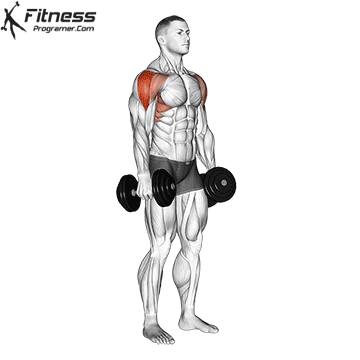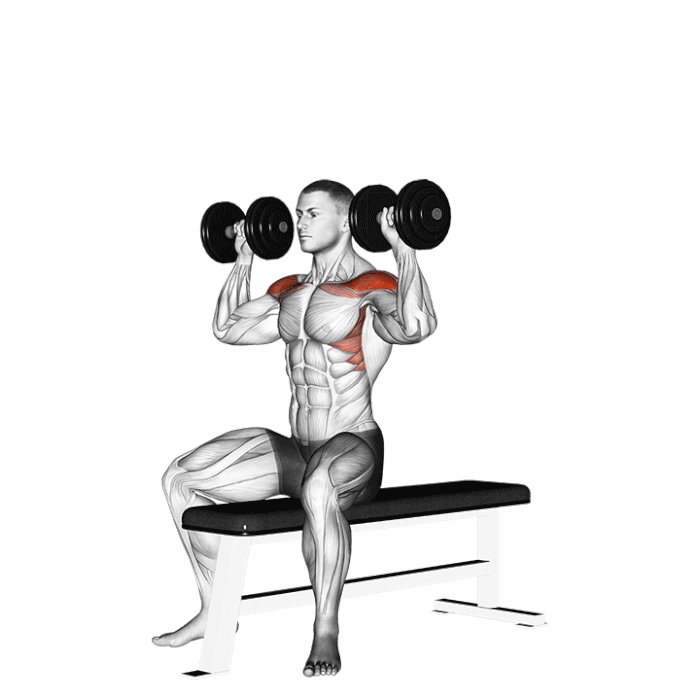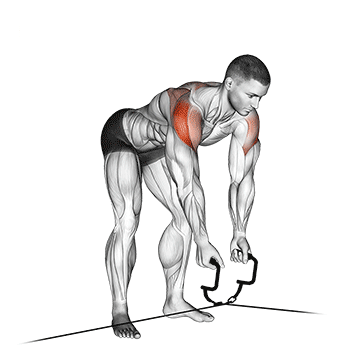BARBELL SHOULDERS PRESS

Barbell Shoulder Press is a fundamental exercise for developing the deltoid muscles of the shoulders, as well as engaging the triceps and upper chest. It is performed standing or seated and involves pressing a barbell overhead
- How to Perform Barbell Shoulder Press
SETUP
- Stand with your feet shoulder-width apart or sit on a bench with back support, keeping your back straight.
- Grip the barbell with your hands slightly wider than shoulder-width apart. The barbell should rest on your upper chest or shoulders
STARTING POSITION
- Keep your elbows bent and the barbell positioned just above your chest. Your wrists should be straight and aligned with your forearms.
- Engage your core and maintain a neutral spine.
EXECUTION
- Press the barbell overhead by extending your arms and straightening your elbows. Keep your movements controlled and avoid arching your back.
- Continue pressing until your arms are fully extended, but do not lock your elbows
RETURN TO POSITION
- Slowly lower the barbell back down to the starting position, just above your chest, by bending your elbows.
- Maintain control of the barbell throughout the movement.
BREATHING
- Exhale as you press the barbell overhead and inhale as you lower it back down.
DUMBBELL LATERAL RAISE

Dumbbell Lateral Raise is a popular shoulder exercise that specifically targets the lateral (side) deltoid muscles. This exercise helps in building width and definition in the shoulders, contributing to a more aesthetically pleasing physique and improved shoulder strength.
- How to Perform Dumbbell Lateral Raise
SETUP
- Stand with your feet shoulder-width apart and hold a dumbbell in each hand at your sides, palms facing inwards
- Maintain a slight bend in your elbows and keep your core engaged to stabilize your body
STARTING POSITION
- With a straight back and neutral spine, let the dumbbells hang at your sides.
EXECUTION
- Raise the dumbbells out to the sides, keeping your elbows slightly bent, until your arms are parallel to the floor.
- Focus on lifting the weights with your shoulders rather than your hands, and avoid swinging your body.
RETURN TO POSITION
- Slowly lower the dumbbells back to the starting position with control.
- Keep the movement steady and avoid letting the weights drop quickly
BREATHING
- Exhale as you lift the dumbbells up and inhale as you lower them back down.
DUMBBELL FRONT RAISE

Dumbbell Front Raise is an exercise that targets the anterior (front) deltoid muscles of the shoulders. It helps in developing the front part of the shoulder and improving shoulder strength and definition.
- How to Perform Dumbbell Front Raise
SETUP
- Stand with your feet shoulder-width apart and hold a dumbbell in each hand in front of your thighs, palms facing down or facing each other.
- Maintain a slight bend in your elbows and engage your core to stabilize your body.
STARTING POSITION
- Keep your back straight and your torso upright.
- Let the dumbbells hang naturally in front of you.
EXECUTION
- Raise the dumbbells straight up in front of you to shoulder height, keeping your arms straight with a slight bend in the elbows.
- Focus on using your shoulders to lift the weights, avoiding any swinging or jerking motions.
RETURN TO POSITION
- Slowly lower the dumbbells back to the starting position in a controlled manner.
- Maintain a steady pace and avoid letting the weights drop quickly.
BREATHING
- Exhale as you lift the dumbbells up and inhale as you lower them back down.
SEATED PRESS

Seated Press is a shoulder exercise performed while seated, which helps to target the deltoid muscles (front, side, and rear) and engage the triceps. It can be done with either dumbbells or a barbell and provides a stable base, reducing the risk of lower back strain compared to standing variations
- How to Perform Seated Press
SETUP
- Sit on a bench with back support and keep your feet flat on the floor.
- Hold a dumbbell in each hand at shoulder height with your palms facing forward.
- Keep your back straight and your core engaged.
STARTING POSITION
- Press the dumbbells upward so that your arms are fully extended but not locked out.
- Keep your elbows slightly bent and in line with your wrists.
EXECUTION
- Push the dumbbells upward until your arms are nearly fully extended
- Avoid locking your elbows at the top of the movement.
- Lower the dumbbells back to shoulder height in a controlled manner./li>
BREATHING
- Exhale as you press the dumbbells up and inhale as you lower them back down.
REVERSE CABLE FLY

Reverse Cable Fly is an effective exercise for targeting the rear deltoids (rear shoulder muscles) and the upper back. It helps improve shoulder stability, posture, and overall shoulder strength. The exercise is performed using a cable machine, which provides constant tension throughout the movement.
- How to Perform Reverse Cable Fly
SETUP
- Stand between two cable machines with the cables set at a high position.
- Grab the handles with your palms facing each other and step forward slightly to create tension in the cables.
STARTING POSITION
- With a slight bend in your elbows, pull the handles out to your sides, keeping your arms extended but not locked
EXECUTION
- Pull the handles back in a wide arc until your arms are fully extended to the sides.
- Squeeze your shoulder blades together at the end of the movement.
RETURN TO POSITION
- Slowly bring the handles back to the starting position with control.
- Maintain a steady pace and avoid letting the weights drop quickly.
BREATHING
- Exhale as you pull the handles out to your sides and inhale as you return them to the starting position.